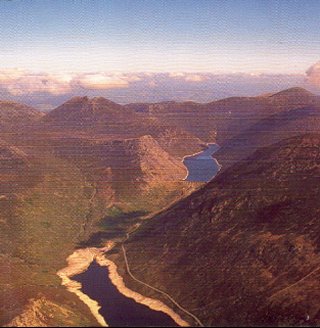This working quarry near Hilltown is interesting for a variety of reasons. It contains a unique seam of rock that is currently very valuable in many aspects of the building industry. Its rock is blocky, hard, sharp and slightly flinty in texture. The homogenous blocks are contrasted with, for example, the fissilated [wafer-like] shales more common to the region. Its grain size is smaller than the average. It is under the ownership and excellent management of P Fitzpatrick Quarries who are fully aware of the valuable resource and practice good environmental control.
The Silurian marine sands of Counties Armagh and Down were converted through metamorphism to a rock type known as greywacke. The rock was first metamorphosed in situ at the creation of Pangea some five hundred million years ago [as detailed elsewhere on these pages]. Much more recently this seam – a 3 km corridor of rock between the two large granite intrusions of Newry [to the north] and Mourne granites – was again baked and metamorphosed a second time. This has lent it its unique qualities.
Leod Quarry thus works a slightly hornfelsed Silurian greywacke of a finer grain than most rocks of this group. Unusually the greywacke here is found in relatively thin beds of less than 1m in thickness, separated by very thin partings of shale or slate. To use the industry’s terms, it has a slightly higher Polished Stone Value (PSV) than the majority of greywacke in the Longford-Down Inlier [to which it belongs]. The quarry’s stone consistently returns PSV of 60+ (the industry minimum limit for road surfacing is ~60) and has a typical value of 62. In detailed description, very hard quartz and feldspar grains, about 2mm across, have been cemented together by recrystallized clay in the form of chlorite and mica. It is this cementing which gives the high PSV by virtue of differential wear, where the quartz and feldspar grains stand proud of the slightly softer chloride/mica matrix. It is most unusual in not containing any carbonates within it. The result is that even in prolonged abrasion, the difference in hardness of the constituent minerals produces and maintains a rough, sand-paper like surface, desirable on our roads.
The rock at Leod crushes to give an excellent aggregate of the trade group, Gritstone, with properties important to its use in concrete, road construction, bituminous materials and even rail ballast. Because the surface of the rock has a rough texture, it has a welcome water absorption value of ~ 0.5-0.8%; this means it binds well to both cement and bitumen. Where Gritstones are employed in road-surfacing, it is important that they do not abrade rapidly. The Aggregate Abrasion Value (AAV) must be determined. Rock from Leod has an extremely high resistance to abrasion: typical values of <4 have been recorded, where normally value of <10 are requested.
Aggregate Crushing Values (ACV) and Impact Values (IV) for Leod are excellent too, consistently returning <15 on both tests. ACV and IV values of <30 are perfectly acceptable for most road construction, concrete etc. but the lower, the better. Because the rock at Leod has been ‘baked’ it tends to be a lot harder than other Gritstones. It has a greater resistance to attrition, which even the layman will understand makes it most suitable for rail ballast. It is employed by both rail companies in Ireland and some is exported for this service. It is estimated that >15% of the Irish rail ballast is sourced from here. With a reserve of ~350,000 tonnes of stone, at present rates of extraction, Leod could continue to function for up to a century.
